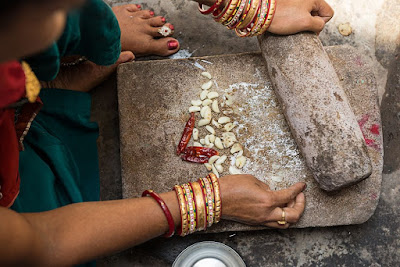Gujarati Cuisine (part-2)
In my previous blog Gujrati Cuisine part-1 I have mentioned that there are so many varieties of Gujarati snacks present other than dhokla and fafda. After the Gujrati Cuisine part-1 we are here with the
Gujarati cuisine (part-2). This blog will include the variety of main courses that served in this cuisine. As
we have seen that how "Gujjus" mix and match the flavors and make dishes more
interesting and happening. Now moving forward let’s see that how they play with
flavors while making curries, rice, dal, roti (chappati) etc.
So, here are some lip smacking Gujarati main course dishes enlisted :-
1.
Sev tameta nu
shaak
This delicious sweet, spicy and tangy gravy is really very
easy to make. Oops! I forgot to decode it, so here I go: - “Sev”-crispy fried
gram flour vermicelli and “Tameta nu shaak”-tomato curry. This dish is combination of gravy and
crispies (i.e. sev). The sev is not only used to garnish the tomato curry but
to push the flavors of the curry to next level.
Key ingredients - Sev, tomato, ginger and coriander.
2. Puran Poli
It’s a kind of stuffed parantha or stuffed flat bread which
is sweet in taste. The filling(Puran) of this parantha is the mixture of
skinned split Bengal gram/chana dal, jaggery and fennel powder etc. and then
the poli is made up of wheat flour and
ghee(clarified butter). This can be served with yogurt, tea or warm milk. This
flatbread is mostly consumed in winters as it consist of jaggery which usually
increases the body temperature.
Key ingredients- Bengal gram flour, jaggery and wheat flour.
3. Thepla
It’s a kind of soft flatbread which can be enjoyed in any
meal of the day. The best part is that it’s much lighter than chapatti and of
course it taste better; as it consist of besan (chickpea flour), methi, ajwain
(carom seeds), wheat flour and so on. This is mostly served with spicy chilly
pickle, chutney or tea.
Key Ingredients- Besan,wheat flour and Methi .
4. Gujrati Kadhi
This kadhi is white in color and it’s sweet in taste.
Obviously, as I said previously that Gujjus always balances the taste and add
the twist of sweetness in most of their dishes. This kadhi helps in lowering
down the body temperature and hence mostly consumed in summers. This can be served with steamed rice or roti.
Key Ingredient - curd, besan and jaggery.
5. Undhiyu
This dish tastes authentic when it’s prepared in earthen
pots and the process of cooking Undhiyu is bit different and unique. Undhiyu is
derived from the word “Undhu” which means upside down. As the “Matlu” or “Matla”
(i.e. earthen pot) is placed upside down and sealed tightly. One can also say
it’s a kind of “One pot vegetable” dish, as it includes varieties of vegetables
in an earthen pot and prepared by a slow cooking process. This also taste
spicy, sour and sweet like all other Gujrati dishes. This can be served with
shrikhand, pooris or roti.
Key ingredient - surti papdi (Indian beans), small brinjals,
pigeon peas, sweet potato and potato.
Interesting? isn't it? So many dishes with so simple and delicate preparation.You guys want more cuisine related post? then comment below.
till then Happy Burping!!









































